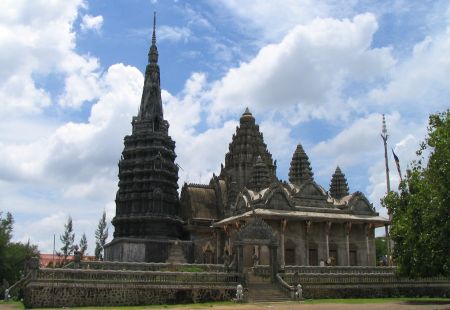KAMPONG CHAM
Kampong Cham is a province in the east of Cambodia. TheMekong river bisects the province. Its capital is Kampong Cham city. With a population of over 1.6 million inhabitants, Kampong Cham is Cambodia's most populous province.
- 0301 Batheay
- 0302 Chamkar Leu
- 0303 Cheung Prey
- 0304 Dambae
- 0305 Kampong Cham
- 0306 Kampong Siem
- 0307 Kang Meas
- 0308 Koh Sotin
- 0309 Krouch Chhmar
- 0310 Memot
- 0311 Ou Reang Ov
- 0312 Ponhea Kraek
- 0313 Prey Chhor
- 0314 Srey Santhor
- 0315 Stueng Trang
- 0316 Tbuong Kmoum
From Wikipedia, the free encyclopedia
- Kampong Cham Province, a province of Cambodia
- Kampong Cham (city), the capital city of Kampong Cham Province
- Kampong Cham District, a district in Kampong Cham Province
- Kampong Cham (commune), a commune in Kampong Cham District
- Kampong Cham Airport, the provincial airport in Kampong Cham Province
- Apostolic Prefecture of Kompong Cham, a geographical area used by the Catholic Church in Cambodia
Phnom Han Chey (Phnom Chey Kiri)
Han Chey or Phnom Chey Kiri is located in Han Chey village, Han Chey commune, Kampong Siem district, about 18 kilometers east of Kampong Cham provincial town on the northern part of the Mekong River. The distance by water is 20 kilometers.

The top of the mountain is located by climbing 295 steps. On the top of the mountain there is a pagoda and temple known as South Kuk temple. Constructed of solid brick made of red clay, it is 7 meters square and 12 meters high. South Kuk temple was built in the seventh century during the reign of King Isanavarman I. Much of the temple has collapsed. Next to it is a second temple made of sandstone. It is 2 meters cubic in circumference and has a roof.
At the foot of the mountain, there is another temple made of basalt called Neang Khmao temple or Noth Kuk temple. It is 7 square meters. Today this temple is near collapse, because it has not been maintained.

Phnom Hanchey view
Many tourists visit these sites many foreigners prefer to come by water, and they often travel in groups. Phnom Han Chhey is 63 meters high offers the tourist beautiful views of the countryside and Mekong River from it submit.
Phnom Pros
Phnom Bros is a dull peak hill about 30 meters high. on the hill is a pagoda named Wat Sovankiri Rattanak Phnom Pros. it has a spot for vehicles to part at the top. the main temple is five peaks, constructed in the style of Banteay Srei temple in Siem Reap. another temple on the Phnom Pros has two peaks and was constructed during the Sangkum Reastre Nyum regime of then-Prince Norodom Sihanouk.near the temple is a 15-meter-high stupa, which was constructed by a monk named Keo Suor, who was the first head monk of the pagoda. a Kot is at the foot of the hill.

Phnom Pros in Kampong Cham
From 1975 to 1979, during the Khmer Rouge regime, Phnom Pros was used as a prison and torture center.about 1.000 meters north of Phnom Pros, there is another higher hill with a sharp-pointed called Phnom Srei.there is also several smaller hills at Phnom Srei called Phnom Dangrek, Phnom Ly and Phnom Chhuk. visitors can reach the peak by climbing308 steps. at the top are the remnants of a destroyed temple. no monk live there, however, there is a Daun Chi2 who cares for the site and asks visitors for donation to rebuild the temple.
This site popular with Cambodians during traditional festivals like Khmer New Year and Pchum Bin. the top of the hill affords visitors a beautiful view of Kampong Cham Province.



 Nokor Bachey temple is a cultural and historical site. It is located 2.2 kilometers from Kampong Cham provincial town along National Road 7, about 122 kilometers northeast of Phnom Penh. Visitors traveling from Phnom Penh will see the gate to the pagoda on right. The temple was built in the middle of the 11th century, during the reign of Suryavarman II and King Ouphey dedicating to Brahmanism. The temple is about 200 meters inside the gate. The site is accessible to almost all type of vehicle. The temple is divided as followed:
Nokor Bachey temple is a cultural and historical site. It is located 2.2 kilometers from Kampong Cham provincial town along National Road 7, about 122 kilometers northeast of Phnom Penh. Visitors traveling from Phnom Penh will see the gate to the pagoda on right. The temple was built in the middle of the 11th century, during the reign of Suryavarman II and King Ouphey dedicating to Brahmanism. The temple is about 200 meters inside the gate. The site is accessible to almost all type of vehicle. The temple is divided as followed:










